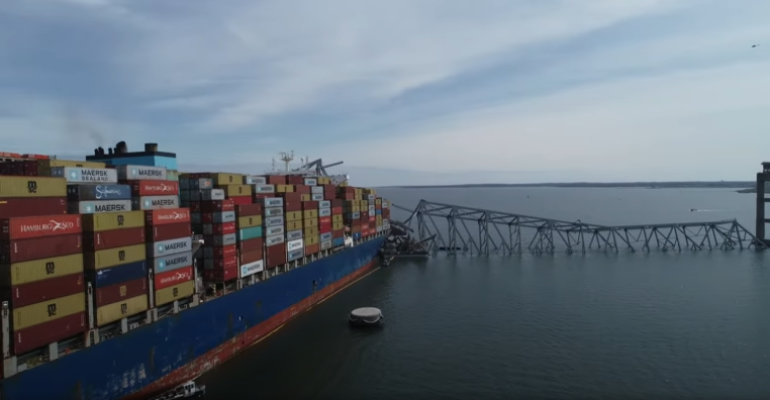The terrible vessel allision at Baltimore’s Francis Scott Key Bridge - part of the I-695 motorway over the Patapsco River - will leave the Port of Baltimore closed for an indeterminate, but certainly considerable, length of time.
The port’s location at the upper reaches of the Chesapeake Bay, about fifty miles northeast of Washington, DC, makes Baltimore important to supply chains in the Northeastern region of the United States. In a televised address, President Joe Biden pledged Federal support for a re-building a new bridge- likely a years-long project - on the eastern side of the Beltway circling around the city.
The Department of Transportation’s (USDOT) Secretary Pete Buttigieg, in a subsequent news conference, described the bridge as being not an ordinary crossing, but, rather “One of the cathedrals of American infrastructure”. The USDOT was ready to approve any requests for funding coming from the President; initial work will concentrate on clearing the channel linking the port to the Chesapeake Bay, allowing vessels to access berths rendered inaccessible by the allision.
The port itself is diversified; though Baltimore sits in the middle of the “I-95 corridor” linking the Northeast megalopolis, it does appear in the top league of US container ports. 2023 saw total throughput of 1,126,511 teu in Maryland Port Authority (MPA) terminals, compared to 3.7m teu moving through Ports of Virginia in a comparable period, and 7.8m teu moving through the Port of New York-New Jersey.
In contrast to ports feeding intermodal networks deep into the hinterlands, Baltimore’s container moves link the densely populated region within 100 miles of the docks, with few moves exceeding 70 miles. The 2023 totals included 793,000 loaded containers, roughly equally split between inbound and export moves. With a channel depth at 50 ft, Baltimore benefitted from the movements of neo-Panamax vessels, like the 9,900 teu Dali, starting in 2016.
The Baltimore port is the leading US mover of automobiles and other vehicles- feeding a significantly broader hinterland than the box trades, via the interstate motorway networks and some rail. 2023 saw moves of 389,000 finished automobiles with a substantial majority, 282,000 being imports; when ro-ro cargo is considered, the total more than doubles.
The port’s Dundalk Marine Terminal features an extensive 300 acres for automobiles and other ro-ro cargo. According to the MPA, “…the combined space auto handling terminals in the port offer a total of 710 acres for autos and ro-ro cargoes.” Local observers did point out that Volkswagen and BMW have been utilizing the recently developed Tradepoint facility at Sparrows Point, the one time hub for now defunct Bethlehem Steel, located outside of the downed bridge. The MPA had been in the permitting stage for a container terminal at a nearby site.
On the bulk side-the port figures in movements of cargo through private terminals outside the realm of the MPA. Baltimore, in close proximity to the coal fields of West Virginia and southern Pennsylvania, is second among US ports in export tonnage, exceeded only by the docks at Hampton Roads and Newport News in Virginia. The port’s two major coal terminals- Curtis Bay Coal Piers - linked to owner CSX railroad - and a terminal owned by Consol Energy, are both inside the harbor.
Data from the US Department of Energy shows Baltimore exported about 20.3m short tons of coal in Jan-Sept, 2023, up from 14.3m short tons in the same period 2022. About 13.3m short tons of exports from Baltimore during this period was steam coal, with the balance, 7.0m short tons, being metcoal for steelmaking. Local observers also point to Baltimore’s position as the leading import destination for cargoes of raw sugar and for gypsum.
Copyright © 2024. All rights reserved. Seatrade, a trading name of Informa Markets (UK) Limited.
Add Seatrade Maritime News to your Google News feed.  |

